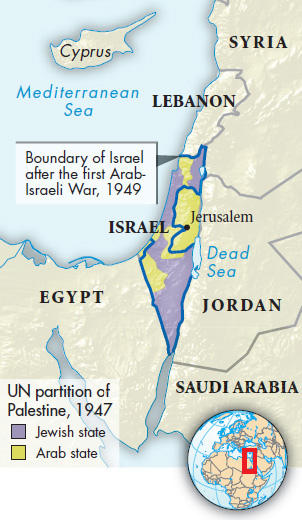Independence and Conflict in the Middle East

In some areas of the Middle East, the movement toward political independence went relatively smoothly. The French League of Nations mandates in Syria and Lebanon had collapsed during the Second World War, and Saudi Arabia and Transjordan had already achieved independence from Britain. But events in the British mandate of Palestine and in Egypt showed that decolonization in the Middle East could be a dangerous and difficult process.

As part of the peace accords that followed the First World War, the British government had advocated a Jewish homeland alongside the Arab population (see “The Peace Settlement in the Middle East” in Chapter 25). This tenuous compromise unraveled after World War II. Neither Jews nor Arabs were happy with British rule, and violence and terrorism mounted on both sides. In 1947 the frustrated British decided to leave Palestine, and the United Nations voted in a nonbinding resolution to divide the territory into two states — one Arab and one Jewish. The Jews accepted the plan and founded the state of Israel in 1948.
The Palestinians and the surrounding Arab nations viewed Jewish independence as a betrayal of their own interests, and they attacked the Jewish state as soon as it was proclaimed. The Israelis drove off the invaders and conquered more territory. Roughly nine hundred thousand Arab Palestinians fled or were expelled from their homes, creating a persistent refugee problem. Holocaust survivors from Europe streamed into Israel, as Theodor Herzl’s Zionist dream came true (see “Jewish Emancipation and Modern Anti-Semitism” in Chapter 23). The next fifty years saw four more wars between the Israelis and the Arab states and innumerable clashes between Israelis and Palestinians.
The Arab defeat in 1948 triggered a powerful nationalist revolution in Egypt in 1952, led by the young army officer Gamal Abdel Nasser (1918–1970). The revolutionaries drove out the pro-Western king, and in 1954 Nasser became president of an Egyptian republic. A crafty politician, Nasser advocated nonalignment and expertly played the superpowers against each other, securing loans from the United States and purchasing Soviet arms.
In July 1956 Nasser abruptly nationalized the foreign-owned Suez Canal Company, the last symbol and substance of Western power in the Middle East. Infuriated, the British and the French, along with the Israelis, secretly planned a military invasion. The Israeli army invaded the Sinai Peninsula bordering the canal, and British and French bombers attacked Egyptian airfields. World opinion was outraged, and the United States feared that such a blatant show of imperialism would propel the Arab states into the Soviet bloc. The Americans joined with the Soviets to force the British, French, and Israelis to back down. Egyptian nationalism triumphed: Nasser got his canal, and Israel left the Sinai. The Suez crisis, a watershed in the history of European imperialism, showed that the European powers could no longer maintain their global empires, and it demonstrated the power and appeal of nonalignment.
